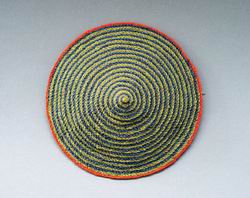Editorial board
The creations of Blanka Cepková M.A. (1966) are a significant programme providing contemporary Slovak textile art with a lively, creative and technical character as well as an expressively rich discipline. It seems that while textile artists were unable to dismiss tradition, they have discovered the wide variety of new expressive possibilities textile fibre and its many designs offer.
Blanka Cepková is a graduate of Prague’s University of Arts, Architecture and Design. She attended the Textile Alternative Studio of Prof. Adela Matasová, completing her studies in 1992. She underwent training in Kybal’s traditions and those techniques that form the classic values of the Czech textile school. On one side, these creations turn away from classical weaving and surface artefact, but at the same time they stand as their own technique of textile fibre processing, a fundamental value of this school. She created her own textile technique, which she then used precisely in a series of jewels featuring a circle motif. Later she extended the use of shapes with new natural motifs in three-dimensional objects. Her inspiration from the natural world is fully expressed in her enamel technique – she plays with the scales of colour tones and structures in order to create poetic signs of reality.
Her creative processes are also influenced by the extraordinary background of the Cepkova family, and she was able to use both her upbringing as well as her artistic talent to form her own expression. Since the autumn of 2004 she has broadened her teaching activities by leading a textile course at the Textile Department of the University of Fine Arts. She also often finds time to lead embroidery courses for ÚĽUV according to her own concept of creativity development of technically developed embroidery makers.
In an interview with Blanka Cepková, she discusses her beginnings and the inspirations for creating jewels and enamel:
“I was always fascinated by sculptures, but later ended up in textiles. When I became a little more experienced at school, I realized that textile does not only have to be a two-dimensional surface, and I started to experiment. I created objects from oakum, a product used by plumbers for insulation. I sew fibres in the same way that baskets are woven, and discovered that if I plat the fibre, the final structure would be flat, weigh less and achieve greater rigidity.
I started working with enamel after returning to Slovakia from Bohemia. I have always felt –and still feel – a little restricted with flat objects. It is an interesting technique, and I am fascinated by the material itself. It provides me with a balance working with three-dimensional objects, where only occasionally do I work with colour. Nevertheless, I miss the volume because enamel does not create it by itself, and colour is required to create the third dimension.
I started to work with jewels through my objects. I was inspired to do so by Austrian jewel maker Peter Skupic, who saw my objects and said that the work was interesting but that it could be transferred into a small form such as a jewel. I continually sought the right form for the jewel. Each jewel had its own architectonic form, a precise shape that is not always typical for textiles. I frequently process a circular motif in many variations. I use copper, brass and silver fibre, which I am trying to process by other jewel techniques such as patina.”
